BEAUTIFUL DESIGN AND UGLY BLIGHT
Who Made This Garden?
I visited a most beautiful garden this week, one in which all the elements of garden design were deftly combined. At ground level groundcovers presented pleasing and harmonious shades of green and varying leaf textures. Leafy plants, lichens, and mosses all contributed to the symphony, the whole scene knit together by large slabs of underlying rock.
In places, low-growing junipers and deciduous shrubs and trees brought the garden up from ground level. Particularly striking was a very large boulder atop of which grew some trees whose exposed roots embraced the boulder before reaching to the ground for water and nourishment. Green moss growing on the boulder erased any starkness from this vignette.

Shakkei, or “borrowed scenery,” an important element in Japanese garden design, played an important role. Distant mountain peaks created a dramatic backdrop in some views.
This garden also utilized what I like to call “luscious landscaping,” that is, the incorporation of dual purpose plants -– for beauty and for eating -– into the landscape. Lowbush blueberry, a plant whose dainty flowers hang like white bells in spring, whose healthy, green foliage ignites in crimson come fall, and whose stems glow red in winter, formed the bulk of the groundcover species. A few lingonberry plants interspersed here and there promised red berries in autumn and evergreen leaves as a foil for those red blueberry stems in winter.
And just where was this wonderful garden? Or gardens, I should say. They were in the high peaks of New York’s Adirondack mountains. The garden designer? God or one described by Darwin, take your pick. Beautiful, at any rate.
Blight Here in the Valley
Back down here on the flatlands, the word “blight” is often bantered around in connection with tomatoes this time of year – your tomatoes, my tomatoes, basically, everybody’s tomatoes! A few years ago, it was late blight (Phytophthera infestans) that was the blight that was of special interest. Attacking both tomatoes and potatoes, this is the same disease that caused the potato famine in Ireland in the 19th century.
Late blight was a problem in the northeast that year due to a particular confluence of events: infected tomato plants offered at “big box” stores gave the blight its start and rainy, humid conditions kept it going.
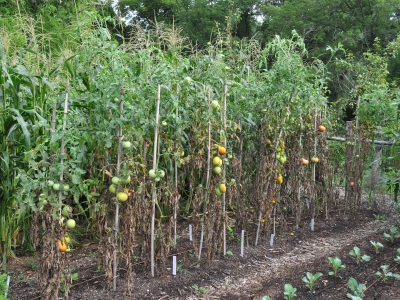
A few years ago; not this year.
The disease does not overwinter here in the north, except on infected potato tubers stored or left in the ground through winter. The way late blight arrives in the north is either on infected transplants or by hitchhiking up from southern fields, where it does overwinter, when weather conditions are just right. The spores can travel about 15 miles at a shot with the right winds coupled with cool, moist weather.
My tomato plants had their usual midsummer splotches and yellowing that year. I usually find pest problems more interesting than scary, I got a little worried about late blight. I tested for it by pulling a splotchy leaf off a plant, sliding it into a plastic bag, and waiting a day. White, fuzzy growth on the leaf would mean late blight. Testing was negative, although blight did eventually show up.
Only under the most severe conditions will I take special measures to control late blight. That year presented those conditions. I decided to spray my tomato plants, a measure to which I’d never before resorted. And it’s not because I grow mostly heirloom tomatoes; pretty much any and every tomato variety is susceptible to late blight. I used one of many copper sprays that are organically approved, still taking care not to dowse nearby other plants and to thoroughly protect myself while spraying.
Blight. What’s That?
That’s not to say all my tomato plants are the pictures of health this year, or any year. They do get some leaf yellowing and loss due to disease. Three diseases, in fact. One is the already mentioned late blight. The other two, which do rear their ugly heads reliably every year, are early blight and septoria leaf spot.
If you look closely at the leaf damage, you can tell which one(s) your tomatoes are hosting. Early blight (Alternaria solani), the most common of the three, marks leaves with dark-brown, round spots a half-inch in diameter, each surrounded by concentric rings.
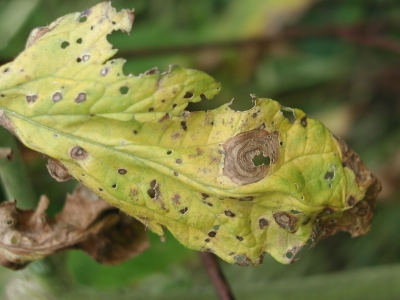
Early blight
Septoria leaf spot (Septoria lycopsersici) causes spots that are small, round and gray, each surrounded by a single, dark margin.
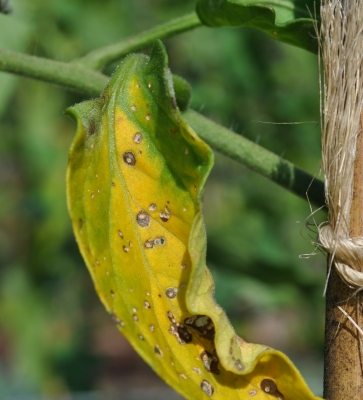
Septoria leaf spot
And late blight causes greenish-black splotches.
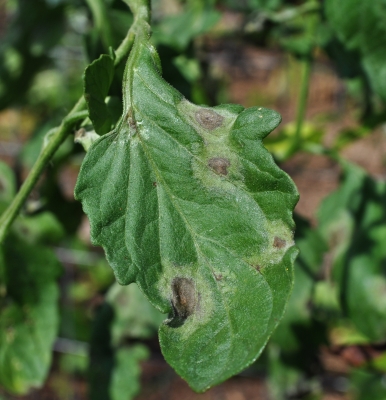
Late blight
The names of any one of the leaf spot diseases is enough to conjure up fear of plague, but fortunately, all three can be lumped together when it comes to control. The first line of defense against any of the leaf-spot diseases is to keep disease spores away from tomato plants. Spores spend the winter in old plant debris, then are awakened and splashed onto new tomato leaves by rain during the growing season. Early blight and septoria spend the winter in old tomato refuse on the ground. Potato tubers can overwinter this far north on stored potato tubers that are planted out for the next season.
All of which makes a good case for a thorough garden cleanup each fall. At the end of the season I load up my garden cart and haul over to the compost pile old tomato and potato stems, leaves, and fruits.
During the growing season, any mulch — my choice is compost — keeps raindrops from splashing spores up onto plant leaves. Removing infected leaves during the growing season may also help control disease spread. I leave leaves intact, figuring more photosynthesis makes for stronger plants (except, of course, for any leaves too far gone to make a significant contribution to the plant).
Crop rotation each year moves tomato plants away from any spores left from the previous season’s crop. Plant tomatoes in a new location in the garden each year, never returning them to the same spot until four years have elapsed — admittedly a tall order in a small garden.
Another line of defense against leaf spot diseases, many diseases for that matter, is to create an environment inhospitable to them. Fungi thrive in dark, moist, humid places. Let plants bask in full sun without obstructions such as weeds, fences, or other garden plants that would slow air circulation.
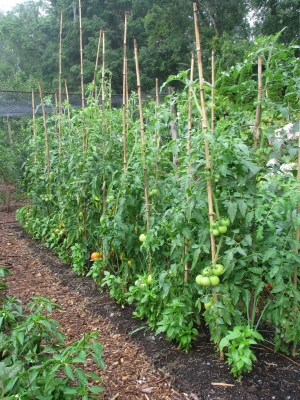
I train each tomato plant to a single stem, which is staked, putting distance between the leaves and any spores on the soil, and exposing the plant to better air circulation. Spaced 18 inches apart, the plants yield less per plant than tomato plants allowed to run wild, but because they utilize a third dimension — up — more tomatoes per land area. Also earlier and with bigger fruits.
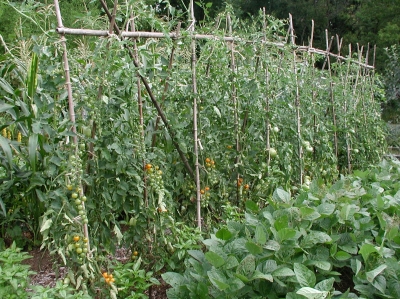


Thanks, Lee, your pictures help clarify how to identify what on tomatoes.
On another note, I have discovered huge, very wiggly worms in my garden last week, probably Asian Jumping Worms, an rapidly invasive species. I understand they are not good for the soil or the plants, and in greater infestations can affect birds, wildlife and native species. They also can apparently out-compete more beneficial earthworms. The adults can reproduce without mating, and tho they do not overwinter, their undetectable cocoons do.
I suspect they came in through a load of organic dirt from a local purveyor.
I’m sad.
Anyway, more here:
http://warren.cce.cornell.edu/gardening-landscape/warren-county-master-gardener-articles/invasive-asian-jumping-earthworms
I first heard about them years ago, from a friend in Rosendale who had them. A couple of years after that, I saw what seemed like evidence of them here on the fardmen, but not in my vegetable garden. The, a year or so later, they were gone. The reason is . . . who knows?
I would like to add anthracnose to that ignoble list.
Yes, definitely. Sunken spots on tomato fruits, especially as weather turns cooler.
I know your tomato philosophy differs a bit from folks like Mike McGrath, who advocates for full-sized plants in big wire cages, and I get that there are benefits and drawbacks to each method. My question is whether you think that the density of single-staked tomatoes that you plant leads to similar levels of space and airflow to the big wire cage method, or if one method might have somewhat of an advantage in that particular arena? My soon-to-be-created beds will be in an area that gets good daytime sun, but won’t get morning sun until 10:30 or so, so I’m trying to think of what will give them the best chance of staving off blights/wilts with sub-optimal morning sun.
The comparison depends on if and how caged plants are pruned, and how far apart single staked plants are. If caged plants are not pruned and single staked plants are 18-24 inches apart, better air flow in the latter. But more tomatoes from the former, assuming disease doesn’t knock them out. My San Marzano tomato plants seem very disease resistant, so I’ll cage them next year.
Thanks, I hadn’t considered a hybrid approach based on disease resistance. I appreciate the idea. Also, any thoughts about root grafting for additional disease resistance in the other varieties?
Root grafting will have little or no effect on leaf diseases.
Thanks for this great piece. I garden in the Finger Lakes region and had a horrible time with what I think was Early Blight brought in by some big box tomatoes. But the real blow was returning to a squash patch after vacation and finding it totally wiped out by Vine Borers. I tried Neem Oil spray this year for the first time and it proved to be a disappointment.
Here’s something else to try, if the squash is a vining type; Cover the stem as it creeps along the ground with moist soil, compost, or mulch. The vine will root where covered and those roots will support the vine even though its original roots can’t move nutrients and water along. It’s worked for me.
I tried this for the first time this year and I did manage to save one vine. Will give it a try again next season
We love you dearly!!
Lee,
The one positive thing I find about the tomato blight is that it provides a lot of green tomatoes to use for some great food recipes. I myself love fried green tomatoes and have a hard time convincing my wife to pick before they are ready, and few markets sell green tomatoes.
Fine, if you like green tomatoes.
You note above ” At the end of the season I load up my garden cart and haul over to the compost pile old tomato and potato stems, leaves, and fruits.” I was of the impression that you should not put the diseased leaves in your compost ,but burn or dispose. Is that not the case?
Others would no doubt disagree with me, but no, I do not think that is the case. I’ve added everything compostable to my compost pile for decades, with no ill effect.My compost piles do get to 140° and sit for about a year before the compost is used. But any compost should be fine if it sits long enough to be thoroughly finished. More heat = less time needed. Lee heat = more time needed.